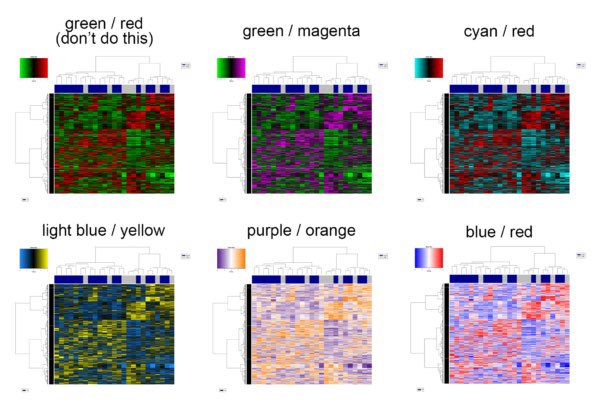Accessibility in science
Created by the ASBMB Maximizing Access Committee (2024)
Statistics
- Roughly 11% of undergraduates in STEM, or about half as many as in the general undergraduate population, report having a disability.
- It’s estimated that ~19% of students enrolling in STEM graduate programs are disabled. However, the percentage of graduate degrees awarded to disabled students still lags at 8–13%.
- As of 2021, only 3% of the STEM workforce identified themselves as disabled.
- It is estimated that 70–80% of disabilities are “invisible,” or not visually obvious, and this can include chronic illnesses, neurodivergence, mental health disorders and more.
Color blindness
As many as 8% of males and 0.5% of females have some form of color blindness, the most common being difficulty in perceiving the difference between the colors red and green. This has implications for your heat maps, microscopy images and other figures in papers and presentations.


Physical accessibility
Wet labs, in general, have been designed for people with no physical challenges. The ability to sit at a lab stool or stand for long periods of time can be barriers, especially to those using walking aids and who need wheelchair access. Visual aids, specific glassware, and lab products that can be used by people with a variety of abilities make the space more inclusive.
“Invisible” accessibility
Flexibility is one of the most important strategies for working with individuals with “invisible” disabilities. For example, permission to work from home (when appropriate), flexible working hours and other accommodations can be beneficial for all workers, but especially those with neurodivergence, a psychiatric disability or chronic illness.
The accommodations process and universal design
Each institution has a different system for accommodations. Accommodations should be sought as soon as possible due to the necessary processing time for documentation. Accommodations can require frequent reassessment and may need to be repeated for each setting (e.g. academic courses, lab work). The approval process for accommodation usually relies on having a physician-diagnosed condition that meets the definition of disability as defined by the Americans with Disabilities Act (ADA) of 1990.
While the medical definition of disability plays an important role in the accommodations process, the definition is focused on the impairments and differences of the individuals. An alternative to consider is the social definition of disability, which states that people are disabled by the mental and physical structures of society, which often fail to provide services to meet the needs of disabled people. This definition places the burden on society to utilize universal design, which is the process of creating products and spaces that are accessible to people with a wide range of abilities. Having captions on videos is a great example of a universal design that increases access to a wide range of people.
